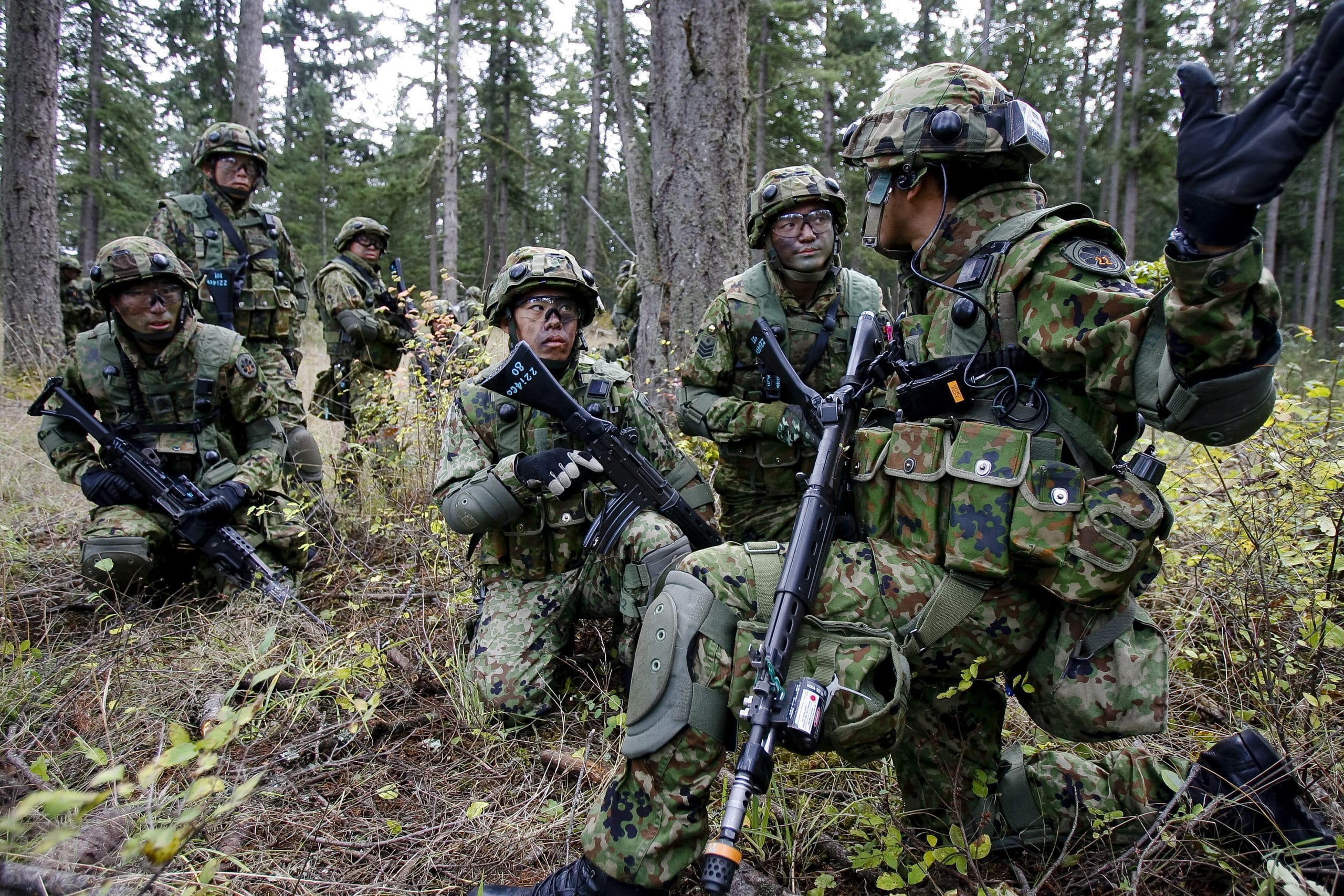December 15, 2020 | Defending Forward Monograph
Japan Remains the Cornerstone of the Pacific
December 15, 2020 | Defending Forward Monograph
Japan Remains the Cornerstone of the Pacific
To deter Chinese aggression in East Asia, Washington has no more capable and reliable ally than Japan. In its 2019 Indo-Pacific Strategy Report, the Department of Defense called the U.S.-Japan alliance “the cornerstone of peace and prosperity in the Indo-Pacific.”1 If Washington and Tokyo are to defend their core interests and deter regional aggression, they must pursue an even stronger defense partnership – one that includes a robust U.S. military posture in Japan, improved Japanese military capabilities, and demonstrated interoperability between U.S. and Japanese forces. Any plans to redeploy U.S. forces from Japan to locations farther away from China, Taiwan, and the South China Sea would be exactly the wrong thing to do.
The United States currently maintains a robust array of forward-stationed military forces in Japan, including approximately 54,250 troops stationed across 85 facilities.2 These forces serve as a key element of America’s forward-deployed defense in the Pacific.
The most capable U.S. forces in Japan are the naval forces that comprise the U.S. 7th Fleet. These include the USS Ronald Reagan aircraft carrier strike group, which has nine modernized cruisers and destroyers in addition to the aircraft carrier and its embarked air wing.3 There is also an expeditionary strike group consisting of Amphibious Squadron 11, the amphibious carrier USS America (equipped with F-35Bs), and four other amphibious assault ships.4 These amphibious ships directly support the III Marine Expeditionary Force (MEF) in Okinawa and together provide crisis/foreign disaster response and theater security cooperation efforts throughout the Pacific.5 These U.S. Navy and Marine assets serve as the “contact” and “blunt” forces called for in the 2018 NDS and allow a quick U.S. response to protect maritime routes and American citizens living in the region. Naval vessels operating in international waters serve as sovereign soil from which the United States can defend troops, allies, and common domains and, if necessary, impose costs on adversaries, without having to coordinate with host nations.6
U.S. air forces are spread across the Japanese islands. Kadena Air Base in Okinawa represents a major concentration of the U.S. presence in the Pacific and would play a prominent role in a conflict with China or North Korea.7 The base permanently hosts F-15 fighter aircraft, KC-135 tankers, E-3 aircraft, and HH-60 helicopters8 and supports F-22 and F-35 fighters for rotational deployments.9 Iwakuni Air Base hosts Navy and Marine air assets, including F-18E/F Super Hornets, EA-18G Growler electronic attack aircraft and United States Marine Corps F-35Bs.10 Misawa Air Base hosts U.S. Air Force F-16C Fighting Falcons. These units can launch from within the first island chain to counter aggression by China’s PLA and establish air superiority, enabling other U.S. forces to enter the region in any contingency.11
U.S. Army forces include strategic communications and combat support, such as the 78th Signal Battalion, which provides joint command, control, and communications (C3) capabilities for U.S. forces throughout the Pacific.12 Army forces also contribute, along with the Navy, to the U.S. integrated Ballistic Missile Defense (BMD) architecture.13 This protects U.S. and Japanese forces by providing early warning and detection of missile threats. BMD assets include Aegis-equipped Navy destroyers, Patriot Advanced Capability-3 (PAC-3) units, and AN/TPY-2 X-band radars.14
Japan enjoys a critical geographic position astride the first island chain near both countries. Beijing understands this and has responded by developing a range of anti-access/area denial (A2/AD) capabilities designed to target and constrain the U.S. military along the first island chain and prevent U.S. “surge” forces from arriving. China will soon have as many as 2,000 cruise, ballistic, and hypersonic missiles capable of targeting bases and forces in and around Japan.15 North Korea also possesses the capability to target bases in Japan.16
China has also pursued an aggressive agenda to coerce Japan into relinquishing sovereignty over the Senkaku Islands. Japan’s Defense Ministry notes that China has already undertaken, “unilateral, coercive attempts to alter the status quo” through territorial incursions in the East China Sea.17 The United States has made it clear that the administrative control of these islands is covered under the U.S.-Japan mutual defense treaty;18 therefore, any aggression toward Japan would not only threaten Japan but also U.S. troops there and the more than 57,500 American civilians living in Japan.19
A failure to retain sufficient U.S. combat power in Japan and along the first island chain would erode deterrence throughout Asia by providing Beijing the opportunity to quickly accomplish its military objectives before U.S. reinforcements could arrive.20 This is due to the “tyranny of distance” associated with the vast expanses of the Pacific. That, combined with the increasingly capable PLA A2/AD threat, would delay U.S. efforts to “surge” contingency crisis reinforcements from Guam, Alaska, Hawaii, or the Lower 48 states.21 Furthermore, reducing U.S. capabilities in Japan would place the second island chain at risk. This includes the U.S. territory of Guam and its approximately 160,000 American citizens.22
Indeed, Japan’s location provides a more effective defense in depth against regional adversaries than any other country in the region. This defense in depth shapes the adversary’s decision making, forcing him to take initial actions far away from U.S. soil, providing the United States time and space for decision making during conflict. Japan’s location complicates Beijing’s risk calculus when considering making a first move against the United States – helping to deter Chinese aggression.23 U.S. forces stationed in Japan also enable the U.S. ability to play a decisive role in contingencies defending South Korea.
Despite this compelling rationale, the risk from the growing A2/AD threat to U.S. forces in Japan has tempted the Pentagon to move U.S. forces farther from China, outside the range of most PLA missiles. In 2019, the Marine Corps announced plans to transfer 5,000 Marines to Guam beginning in October 2024.24 However, this redeployment would undermine U.S. military deterrence of the PLA. Rather than moving them to Guam, the United States should redistribute forces within the first island chain.
To maximize the U.S. position in Japan, adjustments are required. Priorities should be hardening bases and ports that cannot move and building flexibility, lethality, and agility into forward-deployed units, which can then rapidly disperse throughout the archipelago.25 This would maintain the strategic positioning of military assets – but increase survivability. Redistribution would also relieve the pressure on Okinawa, which hosts an outsized and hard-to-defend portion of the U.S. military presence in Japan.26
Japan has a highly capable joint force that is interoperable with U.S. air, maritime, and ground capabilities. Despite spending only 1 percent of GDP on defense, Japan has a navy equipped with Aegis destroyers, quiet diesel submarines, and numerous helicopter carriers and an air force with modern fighters (F-35A, F-15s, et cetera) and support aircraft (E-2D air control and maritime patrol aircraft).27

Japanese soldiers from the 22nd Infantry Regiment of the Japan Ground Self-Defense Force train with American soldiers during a bilateral exercise.
(Photo via the U.S. Army)
Washington, however, must work with Japan to modernize and integrate intelligence, surveillance, and reconnaissance capabilities; secure C3 systems augmented by artificial intelligence; and improve cyber and space capabilities.28 Such efforts will help establish a comprehensive battlefield information network to shorten the time required to detect threats, decide what to do, and deliver the necessary combat effect.29 This is essential to block China’s effort to achieve information dominance through the PLA Strategic Support Force.30
With the support of a new Pacific Deterrence Initiative, the United States should invest in weapons and capabilities for deployment to Japan, as well as in durable infrastructure there to support these systems.31 This is essential to deter a PLA first strike.32 The United States should seek Tokyo’s support to deploy ground-based missiles across several locations in Japan to increase cost-imposition capacity and place the PLA’s A2/AD capabilities at risk in a conflict.33 These assets would create a defensive counter against Chinese missiles for key U.S. logistic nodes and naval vessels. Such deployments would require improvements in infrastructure, such as hardened launch pads and expeditionary airfields, as well as logistical reserves and communication nodes.
The United States should also work with Japan to expand anti-air capabilities in places such as Japan’s southwestern Nansei Islands (a.k.a. Ryukyu Islands) near the Miyako Strait.34 This would help deter Chinese maritime and air incursions and deny China air superiority.35
Additionally, consistent with the U.S. Air Force’s Agile Combat Employment operational concept, the United States should practice dispersing fighter aircraft in smaller sections across Japan to better distribute strike power, prevent multiple losses at one location, and move them farther away from the range of Chinese ballistic missiles.36 Such distribution will create targeting dilemmas for China and ensure the United States can establish and sustain U.S. allied air superiority and integrate with Japanese forces.
On missile defense, Japan, for its part, should enhance its warning and targeting capabilities by installing a distributed network of mobile and fixed sensors and radars, thus ensuring early warning capability against various missile threats.37 Japan should also reassess the capacity of its current short- and medium-range missile interceptors to conduct mutually supporting, overlapping, and reinforcing defense.38 And working with the United States, Japan should ensure the Bilateral Joint Operations Command Center can engage incoming threats with the most appropriate defensive capability.39
To fund these priorities, Washington should encourage Japan to remove its 1 percent of GDP cap on defense spending. Doing so would enable Tokyo to fund increased weapon system procurement and military readiness, increasing Japan’s contribution to the alliance and its posture throughout East Asia. That will be more important than ever in the coming years as the United States and Japan work together to secure common interests that are increasingly under threat.
The views expressed or implied in this commentary are solely those of the authors and do not necessarily represent the views of the U.S. Marine Corps, the Department of Defense, or any other U.S. government agency.
